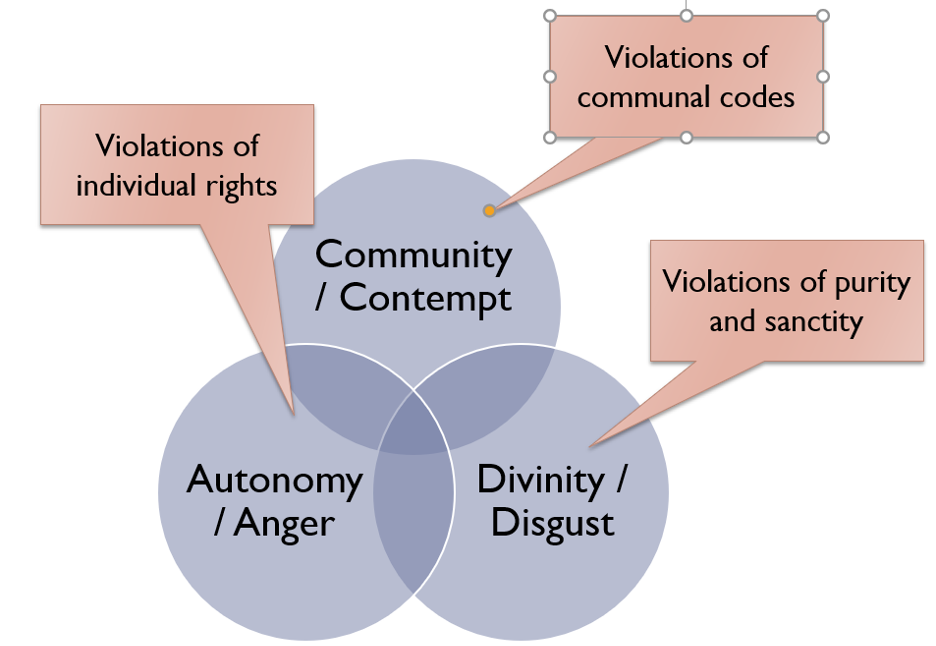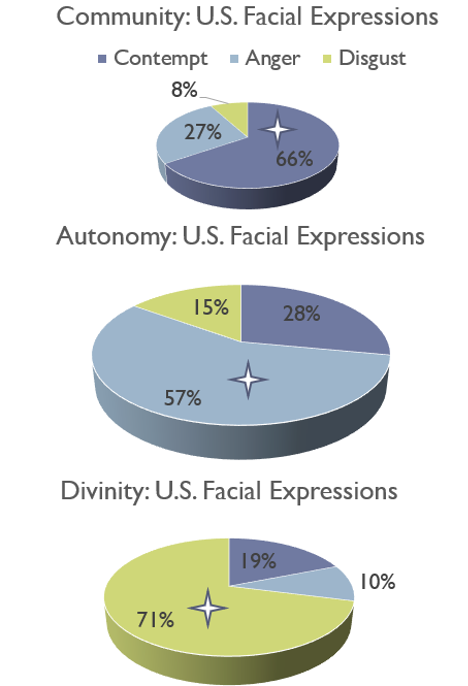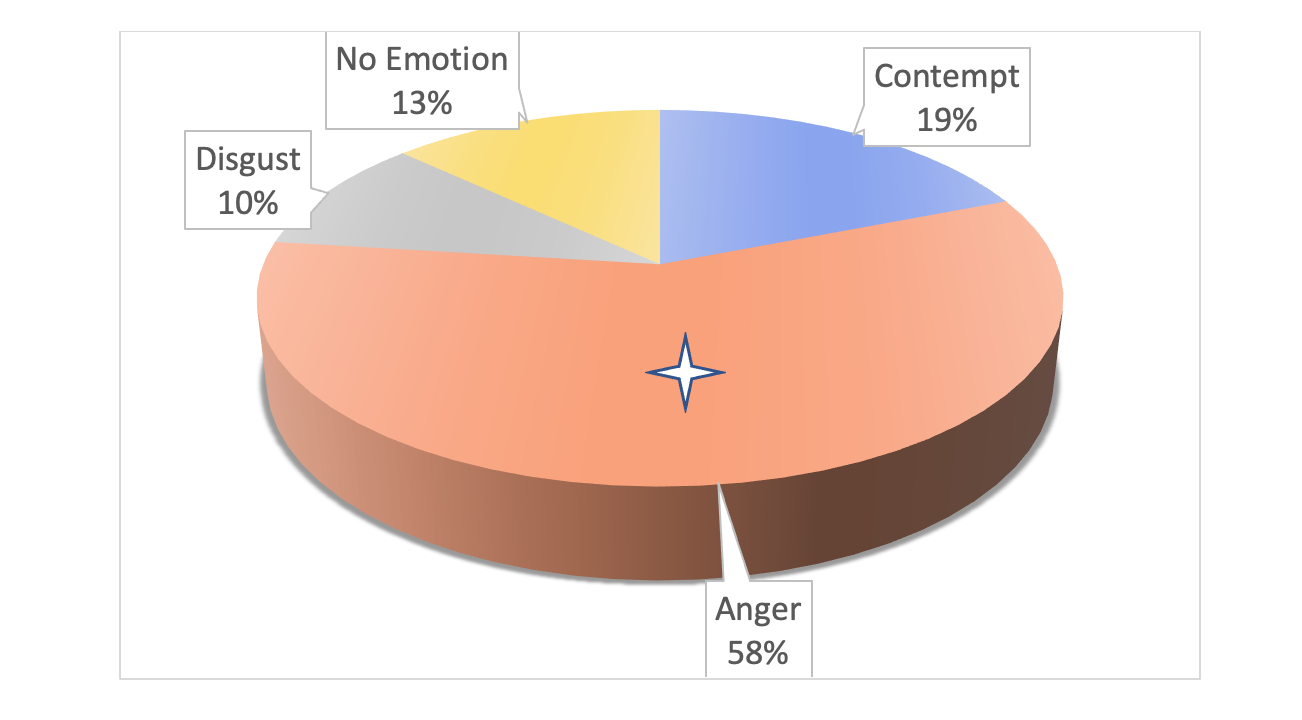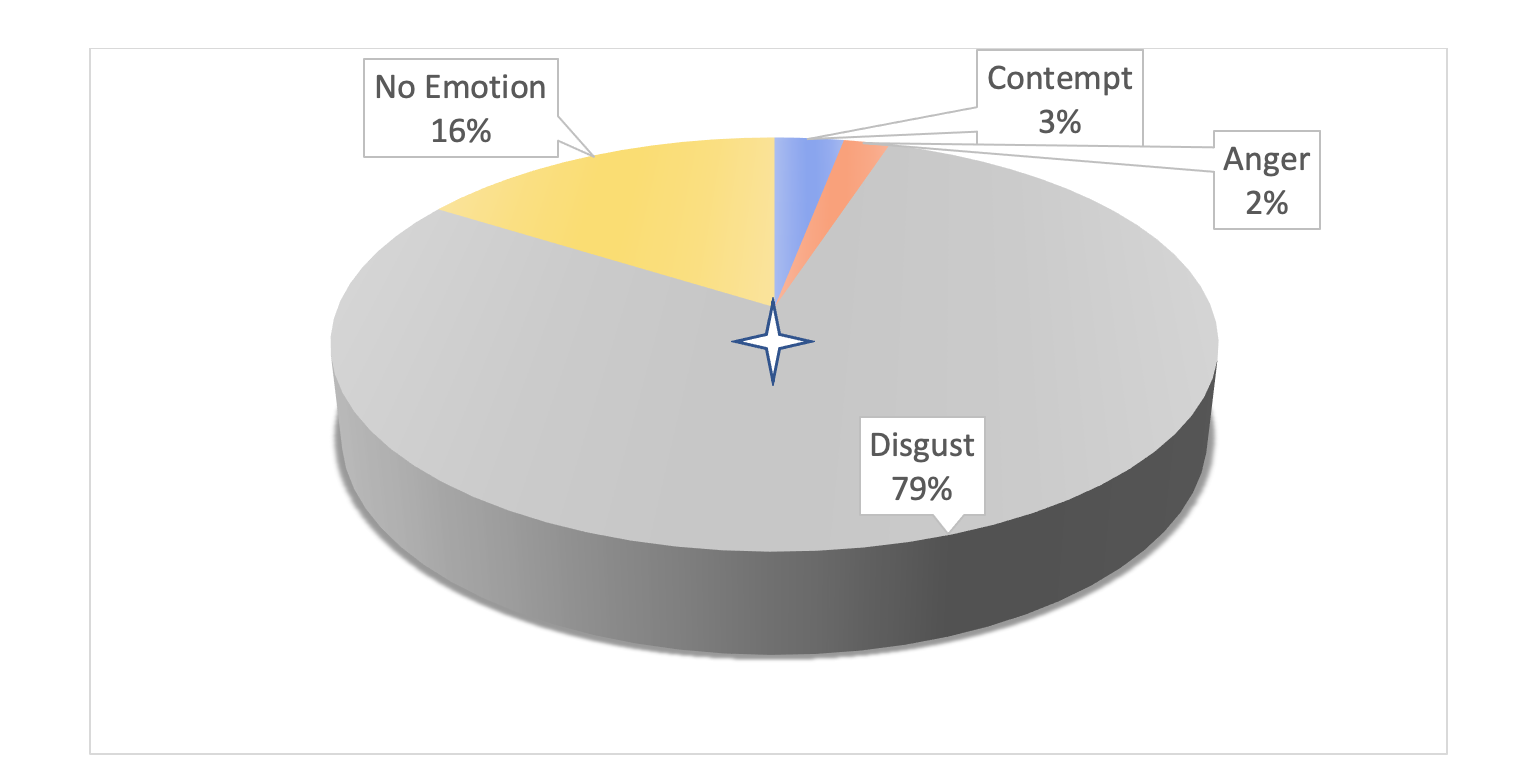Chapter 10: Disgust
The CAD Triad Hypothesis
Figure 18
Visual of CAD Triad Hypothesis

Long Description
The image is a Venn diagram illustrating the CAD Triad Hypothesis. It consists of three overlapping circles labeled “Community / Contempt” at the top center, “Autonomy / Anger” at the bottom left, and “Divinity / Disgust” at the bottom right. Each circle represents different moral emotions and violations. Connected to “Community / Contempt” is a speech bubble labeled “Violations of communal codes” on the upper right. “Autonomy / Anger” is connected to a speech bubble on the left labeled “Violations of individual rights.” “Divinity / Disgust” is linked to a speech bubble on the right labeled “Violations of purity and sanctity.” The circles are shaded in light purple, and the speech bubbles are in light pink. At the top left of the image, the title “Visual of CAD Triad Hypothesis” is displayed.
Community Violation:
occurs when another person does not uphold or behave in line with the duties established by their “community” or social hierarchy. These violations include disrespect toward authority figures and violation of social/cultural norms.
Adapted from “The CAD Triad Hypothesis: A mapping between three moral emotions (contempt, anger, disgust) and three moral codes (community, autonomy, divinity),” by P. Rozin, L. Lowery, S. Imada, and J. Haidt, 1999, Journal of Personality and Social Psychology, 76(4), p. 578 (https://doi.org/10.1037/0022-3514.76.4.574)
Autonomy Violation:
occurs when another person directly violates the individual rights and freedoms of another person. The person who is violated could include the self.
Adapted from “The CAD Triad Hypothesis: A mapping between three moral emotions (contempt, anger, disgust) and three moral codes (community, autonomy, divinity),” by P. Rozin, L. Lowery, S. Imada, and J. Haidt, 1999, Journal of Personality and Social Psychology, 76(4), p. 578 (https://doi.org/10.1037/0022-3514.76.4.574)
Divinity Violation:
occurs when another person disrespects God or religion. Also, occurs when people engage in acts that degrade the soul of the self or other people. These violations include all four types of disgust.
Adapted from “The CAD Triad Hypothesis: A mapping between three moral emotions (contempt, anger, disgust) and three moral codes (community, autonomy, divinity),” by P. Rozin, L. Lowery, S. Imada, and J. Haidt, 1999, Journal of Personality and Social Psychology, 76(4), p. 578 (https://doi.org/10.1037/0022-3514.76.4.574)
To test the CAD hypothesis, US and Japanese students read scenarios that included one of the three moral violations. After reading each scenario, participants selected one of 6 facial expressions and one of three emotion labels to describe the scenario. Each emotion was displayed in two different facial expressions – this allowed researchers to account for different combinations of AUs to represent the same emotion (remember, above we talked about how there may be several different disgust expressions).
The findings for the American participants are displayed below. These results were the same for the Japanese and American participants. For facial expressions, participants matched the facial expression to the correct violation at beyond chance levels. For emotion labels, participants matched the correct label to the correct violation for anger (58%) and disgust (79%; see Figure 19). But, participants did not select the contempt word label for the community violations at a beyond chance level. Interestingly, most participants (43%) labeled the community violations as “no emotion.”
Figure 19
Results for Facial Expressions (Top) and Word Labels (Bottom) for American Participants (Rozin et al., 1999).

Long Description
The image consists of three pie charts labeled “Community,” “Autonomy,” and “Divinity,” each representing U.S. facial expressions categorized into contempt, anger, and disgust.
The first pie chart, labeled “Community: U.S. Facial Expressions,” shows three segments: 66% purple (contempt), 27% blue (anger), and 8% green (disgust).
The second pie chart, labeled “Autonomy: U.S. Facial Expressions,” includes 57% blue (anger), 28% purple (contempt), and 15% green (disgust).
The third pie chart, labeled “Divinity: U.S. Facial Expressions,” has 71% green (disgust), 19% purple (contempt), and 10% blue (anger).
Each chart features a central star icon with three sectors varying in size based on percentage values.
Community Violation: U.S. Word Labels

Long Description
The image is a pie chart titled “Community Violation: U.S. Word Labels.” It is divided into four segments, each representing a different emotion related to community violation. The largest segment, colored yellow, represents “No Emotion” and accounts for 43%. The light blue segment represents “Contempt” with 28%, featuring a star marker. The orange segment represents “Anger,” taking up 20%. Lastly, the grey segment represents “Disgust” at 9%. Each segment is labeled with its corresponding percentage and emotion. The color legend is located above the pie chart.
Autonomy Violations: U.S. World Labels

Long Description
The image is a 3D pie chart titled “Autonomy Violations: U.S. World Labels.” The chart is divided into five segments, each representing different emotions with corresponding percentages. The largest section, colored in orange, represents “Anger” at 58%. The next largest segment is “Contempt” in blue, accounting for 19%. “No Emotion,” colored in gray, comprises 13%, while “Disgust,” in yellow, makes up 10%. Each segment is labeled with its respective emotion and percentage.
Divinity Violations: U.S. Word Labels
Long Description
The image shows a 3D pie chart titled “Divinity Violations: U.S. Word Labels” which illustrates the distribution of U.S. word labels for divinity violations. The chart is divided into various colored segments. The largest gray segment, occupying 79% of the chart, is labeled “Disgust.” A yellow segment, representing 16%, is labeled “No Emotion.” Smaller segments rendered in orange, blue, and red, represent “Contempt” at 3%, “Anger” at 2%, and a sliver for another category, respectively. Each segment includes a label with its percentage, extending outside the pie chart. The title above the chart reads “Divinity Violations: U.S. Word Labels.”
Adapted from “The CAD Triad Hypothesis: A mapping between three moral emotions (contempt, anger, disgust) and three moral codes (community, autonomy, divinity),” by P. Rozin, L. Lowery, S. Imada, and J. Haidt, 1999, Journal of Personality and Social Psychology, 76(4), p. 580 (https://doi.org/10.1037/0022-3514.76.4.574). Copyright 1999 by the American Psychological Association.


